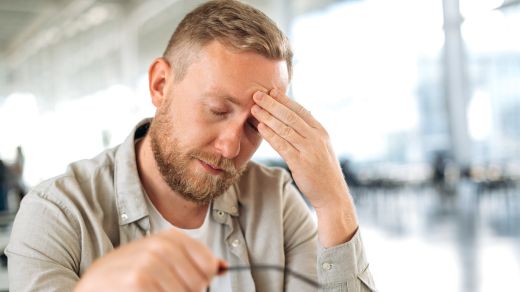Cluster headaches occur as attacks and are always one-sided. The pain attacks are very severe in their intensity. In addition, accompanying symptoms such as a runny nose are also characteristic of the headache form. You can find out what triggers there are and how cluster headaches can be treated here.
- © Getty Images/Kateryna Onyshchuk
Quick overview: Frequently asked questions and answers
What does cluster headache feel like? The headache disorder is characterized by pain of severe to unbearable intensity, which is always localized on one side of the head in the area of the eyes or forehead. Possible accompanying symptoms include watery eyes, redness in the cheeks or temples and a runny nose.
What is the reason for cluster headaches? The exact cause is not clear. However, some triggers can trigger an acute attack, including alcohol and altitude.
How long does a cluster headache attack last? The duration varies from 15 to 180 minutes.
At a glance:
What are Cluster Headaches?
Cluster headaches (also known as cluster headaches) occur in attacks and periodically. Hence the name: “Cluster” comes from English and means “heap”, “group” or “accumulation”.
The one-sided pain in cluster headaches is severe and usually affects the eye, temple or forehead region.
Other names for this type of headache are:
- Bing Horton neuralgia
- Histamine headache
- Erythroprosopalgia
- Sluder neuralgia
- Hemicrania periodica neuralgiformis
Frequency of cluster headaches
Cluster headaches are rare. In Germany, around 70,000 people suffer from this type of headache, and around two thirds of those affected are male. In the majority of cases, the first cluster attacks occur between the ages of 30 and 40.
Types of cluster headaches
Depending on the frequency of occurrence, cluster headaches can be divided into episodic and chronic cluster headaches.
Episodic cluster headaches: Episodic pain accounts for around 75 percent of cluster headaches. There are long pain-free intervals (remission phase) that last between two weeks and several years. These are replaced by pain phases in which pain attacks occur regularly. These phases last between two weeks to two months and are particularly common in spring or autumn.
Chronic cluster headaches: If the pain phases are very long or the remission phases are very short, we are talking about chronic cluster pain. This is diagnosed if there have been no headache-free periods for over a year, or the pain-free period has been less than two weeks. The headache attacks occur regularly, often at the same time of day, about one to two hours after falling asleep or just before waking up.
Cluster headaches: symptoms and accompanying symptoms
Cluster headaches differ from tension headaches because they occur suddenly and always on one side and are very severe to almost unbearable. As a rule, the pain is localized in the area of the eyes, forehead or temples. Those affected describe the pain as:
- drilling,
- stabbing,
- cut or
- burning.
An attack lasts about 15 to 180 minutes, then the pain subsides. Several attacks are possible per day; on average, one or two such attacks occur per day during periods of pain.
Unlike migraines, exercise can provide mild relief for cluster headaches. That’s why those affected often pace up and down restlessly. Some people also become very irritable or even aggressive during a pain attack.
Possible accompanying symptoms
In addition to the headache, there are often other symptoms. The main characteristic feature is redness in the affected eye, and sometimes it also waters. The following symptoms are also typical:
- runny nose
- Sweating and redness of the skin in the forehead and cheeks area
- Sensitivity to light
- Noise sensitivity
- Swelling on the eyelid
- Drooping of the affected eyelid
- Reduction of the pupil
In around a quarter of cases, a visual aura (various visual disturbances) occurs before a pain attack, which makes the diagnostic differentiation from migraine difficult.
Cluster headaches: acute treatment
Because the pain intensity is so severe, medication is usually necessary. However, in the event of an acute attack, commonly taken painkillers such as ibuprofen or paracetamol are usually ineffective.
Many sufferers find it helpful to breathe in pure oxygen during the first 15 minutes of an acute attack. For this you need a special oxygen device with a breathing mask.
If that doesn’t work, you can try using sumatriptan. The substance, which is best known for treating migraines, is administered as an injection under the skin. Taking it as a tablet has not proven effective because the medication only begins to work very late.
In addition, a nasal spray with the anesthetic lidocaine has proven effective for relieving an acute attack: the medication is sprayed into the nostril on the affected side.
Prophylaxis to prevent attacks
Since the causes are not exactly known, general prevention of cluster headaches is not possible. However, if the pain attacks occur very often, prophylactic treatment can be considered. The aim is to prevent further cluster attacks. Unlike other types of headaches
not proven. That’s why medications are used. Possible means of prophylaxis are:
- Calcium antagonists such as verapamil
- Triptans such as ergotamine tartrate
- Corticosteroids such as prednisolone
- Antiepileptic drugs such as valproic acid or topiramate
Lithium, which is used to treat depression and mania, is also often prescribed to prevent cluster headaches. Studies also show that local anesthesia of the greater and lesser occipital nerves using corticosteroids provides short-term relief. This is done when other prophylactics do not work quickly enough.
Which medication and which method is used depends on the form of the disease, the frequency of attacks and individual factors and is precisely coordinated by doctors.
What can those affected do?
In addition, those affected can keep a headache diary to identify the exact triggers: This may help prevent some attacks during pain episodes.
Triggers and risk factors for cluster headaches
The causes of cluster headaches have not yet been clearly clarified. It is assumed, among other things, that there is a genetic component because headaches are more common in some families.
It is also discussed whether a disorder in the hypothalamus is the cause of the type of headache: This part of the brain controls, among other things, the day-night rhythm. Imaging techniques show increased activity in this area in patients with cluster headaches. The pain is triggered there and transmitted via the trigeminal nerve to the face, where it can be felt. This hypothesis is also supported by the fact that the pain attacks often occur after falling asleep or shortly before getting up.
In addition, chronic inflammatory processes of nerve fibers and blood vessels are suspected as triggers.
Triggers and risk factors for a cluster attack
As with a migraine, certain stimuli, so-called triggers, can trigger an attack if you already have a cluster headache. As a rule, however, those affected only respond to these triggers when they are in the middle of a pain episode, i.e. the pain occurs more acutely.
Possible risk factors and triggers are:
- Alcohol (especially in small quantities)
- Taking preparations containing nitroglycerin (e.g. to treat angina pectoris)
- nicotine
- glare
- Histamine (e.g. from sausage or cheese)
- Staying at high altitudes
For people with cluster headaches, nicotine is not only a possible trigger for an acute attack – smoking can potentially negatively influence the course and turn episodic pain attacks into chronic cluster headaches.
Cluster headaches: how is the diagnosis made?
The diagnosis usually results from a detailed medical discussion (anamnesis). The exact symptoms, their frequency and duration of occurrence and any triggers are recorded. This is followed by a physical examination, including neurological tests.
In order to rule out dangerous causes of headaches, such as a tumor, imaging procedures such as magnetic resonance imaging (MRI) are also used.
Living with cluster headaches
Cluster headaches are among the most severe headaches of all and can severely limit the lives of those affected. The attacks often occur at night or early in the morning and can affect a relationship and family life. During an attack, patients cannot do any activity; a cluster attack can be dangerous in traffic. Some people also feel restricted by the oxygen machine.
In some cases, those affected are so desperate that they become socially withdrawn, become mentally ill and have suicidal thoughts. That’s why psychotherapeutic support is important for headache disorders.
Are you at risk of suicide? Get help!
Telephone pastoral care (available 24 hours):
- 0800/ 1110111
- 0800/1110222
116 123
An exchange with other affected people can also help to gain new perspectives and find a good way to deal with the topic. You can find information at the Federal Association of Cluster Headache Self-Help Groups (CSG) eV or at: www.clusterkopf.de.


